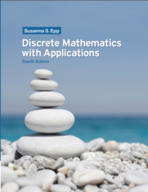A sequence d1, d2, d3,... is defined by letting d1 = 2 and dk = dk1 k for all integers k
Chapter 5, Problem 27(choose chapter or problem)
A sequence \(d_{1}, d_{2}, d_{3}\), . . . is defined by letting \(d_{1} = 2\) and \(d_{k} = \frac {d_{k−1}}{k}\) for all integers k ≥ 2. Show that for all integers n ≥ 1, \(d_{n} = \frac {2}{n!}\) .
Text Transcription:
d_1, d_2, d_3
d_1 = 2
d_k = d_k−1 / k
d_n = 2 / n!
Unfortunately, we don't have that question answered yet. But you can get it answered in just 5 hours by Logging in or Becoming a subscriber.
Becoming a subscriber
Or look for another answer
